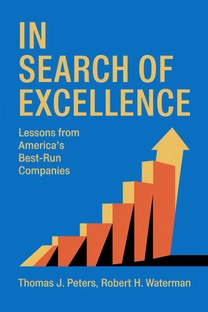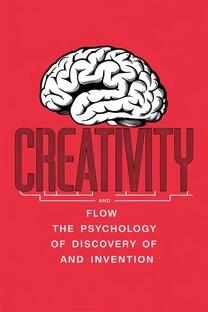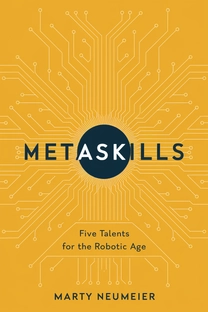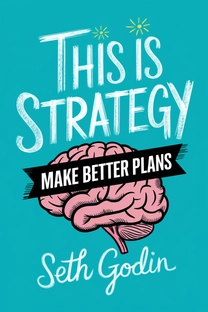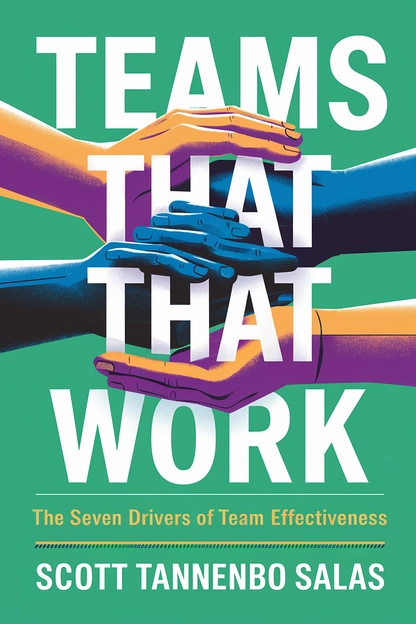
Teams That Work
The Seven Drivers of Team Effectiveness
by Scott Tannenbaum, Eduardo Salas
Brief overview
This book explores how teams thrive by focusing on seven key drivers: capabilities, cooperation, coordination, communication, cognitions, conditions, and coaching. It combines practical examples, cutting-edge research findings, and tactical strategies to illustrate how each element impacts teamwork. By examining real-world stories, it shows why trust, a sense of purpose, and the right environment help teams excel and sustain their performance.
Introduction
Teams can be found everywhere—from corporate offices to hospital wards to sports fields. Yet teamwork remains a puzzle for many, with well-intentioned groups often missing their targets. This book lays out seven drivers crucial to getting results: capabilities, cooperation, coordination, communication, cognitions, conditions, and coaching.
Instead of relying on myth or hearsay, the authors back up each idea with extensive meta-analytic research. They also share compelling stories, from NASA missions to restaurant kitchens, to show how these drivers truly unlock a team’s potential.
While skill alone can get a team started, the real game-changer is how members interact, trust each other, handle conflict, and adjust to changing demands. Through these pages, readers discover practical steps to shape and sustain high performance.
In short, this introduction reveals that effectiveness is rarely about having only superstars. It’s about systematically nurturing each of the seven drivers so that any group—be it a front-line project team or an executive committee—can excel.
The Seven Drivers Overview
The authors pinpoint seven elements—drivers—that influence how teams operate. They see it as a connected system rather than disjointed parts. Missing one component can weaken overall performance.
1) Capabilities: Having the right blend of knowledge and skills. 2) Cooperation: Team members’ beliefs, trust, and attitudes. 3) Coordination: How people synchronize efforts and assist each other. 4) Communication: Clear, timely sharing of unique information. 5) Cognitions: Maintaining shared understanding and mental models. 6) Conditions: The context in which the team functions. 7) Coaching: Effective leadership and guidance.
These drivers build upon one another. For instance, clear communication improves team cognitions, and shared leadership can strengthen cooperation. When each driver is nurtured, teams not only meet goals but remain adaptable and engaged.
No single practice solves everything. The real power lies in knowing which driver to adjust and how to do it. This chapter sets the stage for a deeper dive into each driver, along with real-life applications and ideas for immediate use.
What is Teams That Work about?
"Teams That Work: The Seven Drivers of Team Effectiveness" by Scott Tannenbaum and Eduardo Salas is a groundbreaking guide to understanding and elevating team performance. Delving into the core pillars of capabilities, cooperation, coordination, communication, cognitions, conditions, and coaching, the book presents a holistic approach to team dynamics. It offers an engaging mix of research-backed insights and practical examples, providing a roadmap for teams in any setting to thrive.
Rooted in extensive meta-analytic research, the authors dispel myths surrounding teamwork, showing how trust, a shared understanding, and proper environmental conditions lead to sustainable success. They emphasize that effective teams balance individual expertise with cohesive collaboration, fostering an atmosphere where adaptation, resilience, and enhanced performance are the norm. The book's real-world stories from NASA missions to dynamic restaurant floors spotlight how these drivers unify complex groups into harmonious units.
Through "Teams That Work," readers gain a clear understanding of why nurturing every team member's potential while promoting an inclusive environment is key to achieving coordinated efforts and enduring leadership. By implementing the book's insights, teams from diverse sectors can not only improve their operational efficiency but also build a culture of mutual support and long-term vitality that resonates across organizational levels.
Review of Teams That Work
"Teams That Work" is a profound exploration of what makes collaborative groups excel. Readers are gifted with a treasure trove of insights, stemming from Tannenbaum and Salas' dedication to merging academia with practical wisdom. They've identified and broken down seven universal drivers, revealing the engine behind effective teamwork.
The book's key strength lies in its actionable framework, applicable across industries and team sizes. It's not just about understanding the drivers but leveraging them to suit specific needs, fostering environments where communication and motivation thrive. This adaptability is echoed in the practical applications suggested for each driver, ensuring that teams can readily translate theory into practice.
The authors' writing style steers away from jargon-heavy prose, making it accessible to both seasoned leaders and newcomers to team management. This ensures that regardless of one's role, they can glean valuable takeaways about fostering trust, ensuring role clarity, and maintaining momentum in high-pressure situations. Undoubtedly, "Teams That Work" is indispensable for anyone committed to harnessing their team's potential.
If you're on a quest to elevate your team's performance and cohesiveness, Tannenbaum and Salas' insights provide a clear road map. With every chapter, readers are encouraged to embrace the nuances of team dynamics, preparing them to not only meet but exceed their organizational goals.
Who should read Teams That Work?
- Team Leaders and Managers: Gain strategies to optimize team performance and maintain cohesive group dynamics.
- Human Resource Professionals: Learn to better understand the elements of effective team-building and cultivate ideal working environments.
- Organizational Consultants: Enhance your toolkit for advising businesses on fostering high-functioning teams.
- Business Executives: Obtain insights on aligning teams with corporate objectives to maximize productivity and innovation.
- Educators in Leadership and Team Management: Use the comprehensive research-backed framework to enrich curricula and provide students with actionable insights.
About the author
Book summaries like Teams That Work
Why readers love Mindleap
10-Minute Book Insights
Get the core ideas from the world's best books in just 10 minutes of reading or listening.
Curated For You
Discover your next favorite book with personalized recommendations based on your interests.
AI Book ExpertNew
Chat with our AI to help find the best book for you and your goals.
Reviews of MindLeap
Love how I can get the key ideas from books in just 15 minutes! Perfect for my busy schedule and helps me decide which books to read in full.
Alex R.
The summaries are incredibly well-written and the audio feature is perfect for my commute. Such a time-saver!
Jessica M.
Great app for personal growth. The insights are clear and actionable, and I love how they capture the essence of each book.
Chris P.
The app is beautifully designed and the summaries are top-notch. Definitely worth every penny!
Sarah K.




